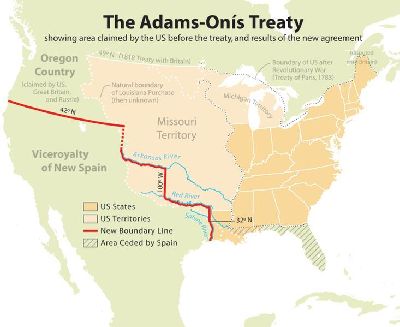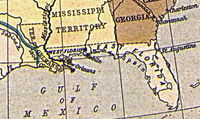The Adams-Onís Treaty of 1819[1] settled a border dispute in North America between the United States and Spain. The treaty was the result of increasing tensions between the U.S. and Spain regarding territorial rights at a time of weakened Spanish power in the New World. In addition to granting Florida to the United States, the treaty settled a boundary dispute along the Sabine River in Texas and firmly established the boundary of U.S. territory and claims through the Rocky Mountains and west to the Pacific Ocean in exchange for the U.S. paying residents' claims against the Spanish government up to a total of $5,000,000 and relinquishing its own claims on parts of Texas west of the Sabine River and other Spanish areas.
History
The treaty was negotiated by John Quincy Adams, the Secretary of State under U.S. President James Monroe, and the Spanish foreign minister Luis de Onís.
Spain's Colonies
While Spain at first refused to rewrite any border in favor of the U.S., Spain had been forced to negotiate because it was losing its hold on its colonial empire, with its western colonies primed to revolt. Specifically, while fighting escaped African-American slaves, outlaws and Native Americans in U.S.-controlled Georgia during the First Seminole War, Andrew Jackson had pursued them into Spanish Florida, but at the same time, he attacked and captured Spanish forts in Florida with absolutely no provocation, thus threatening war with Spain and causing national controversy. Some of Monroe's cabinet demanded Jackson's immediate dismissal, but Adams realized that it put the U.S. in a favorable diplomatic position. Although Spanish power in the New World had long been in decline, Jackson's attacks had exposed how weak Spain was in the New World to the U.S., Latin American revolutionaries, and the other European powers. Taking an aggressive stance, Adams was able to negotiate very favorable terms.
In its weakened state, it was fairly certain that Spain would lose the land to the United States following the Louisiana Purchase in 1803. Spain had questioned the validity of the purchase, stating that France had no right to sell Louisiana because such a sale went against the agreements in the Treaty of San Ildefonso, and furthermore, there was much discussion about the extent of the area that the United States had bought from France. The Spanish had a very restricted view of Louisiana, considering it to comprise the west bank of the Mississippi and the city of New Orleans. The United States on the other hand claimed that the land they bought extended all the way to the Rio Grande and the Rocky Mountains, thus encompassing much of Spain's northern colony of Coahuila y Tejas.
Details of the treaty
In the agreement, the U.S. received the territorial rights to Spanish Florida (British East and West Florida) in exchange for payments by the United States of residents' claims against the Spanish government up to a total of $5,000,000 and relinquishing its own claims on parts of Texas west of the Sabine River and other Spanish areas. The treaty was concluded on February 22, 1819, in Washington, D.C., ratifications were exchanged, and the treaty was proclaimed on February 22, 1821. The U.S. commission established to adjudicate claims considered some 1800 claims and agreed that they were worth $5,454,545.13. Since the treaty limited the payment of claims to $5 million, the commission reduced the amount paid out proportionately by 8 1/3 per cent.
The Adams-Onís Treaty settled the dispute by attempting to draw clearer borders, roughly granting Florida and Louisiana to the U.S. while giving to Spain everything west of Louisiana from Texas to California. The new boundary was to be the Sabine River north from the Gulf of Mexico to the 32nd parallel north, then due north to the Red River, west along the Red River to the 100th meridian, due north to the Arkansas, west to its headwaters, north to the 42nd parallel north, and finally west along the parallel to the Pacific Ocean.
The claims of Spain on the Oregon Country dated to the papal bull of 1493 which had granted to Spain the rights to colonize the western coast of North America and to the actions of Vasco Núñez de Balboa in 1513, when he claimed all the "South Sea" (the Pacific Ocean) and the lands adjoining the Pacific Ocean for the Spanish Crown. To solidify these 250-year old claims, in the late 1700s Spain established a military and trading outpost in today's British Columbia and performed "acts of sovereignty" in today's Alaska. As a result of the Adams-Onís Treaty, the United States acquired the claims of Spain to the Oregon Country north of the 42nd parallel.
Perceived impact on territories
For the United States, this treaty meant that its claimed territory now extended far west from the Mississippi, all the way to the Pacific Ocean. For Spain, it meant that it kept its colonies in Texas and also kept a buffer zone between its colonies in California and New Mexico and the US territories. Adams considered this to be his greater achievement, as he foresaw that Oregon would allow trade with the Orient and economic powers in the Pacific.
Later problems with the treaty
The treaty was ratified by Spain in 1820, and by the United States in 1821 (during the time that Spain and Mexico were engaged in the prolonged Mexican War of Independence). The Adams-Onís treaty was concluded with Spain, and war with Spain was delayed for 77 years. While Mexico was not initially a party to the treaty, in 1831 Mexico had ratified the treaty, including setting the 42nd parallel as the northern boundary of California. However, by the mid-1830s, a controversy developed regarding the border with Texas, during which the United States claimed that the Sabine and Neches rivers had been switched on maps, thus attempting to claim more land. As a consequence, the eastern boundary of Texas was not firmly established until the independence of the Republic of Texas in 1836, and not agreed upon until the Treaty of Guadalupe Hidalgo in 1848 which concluded the Mexican-American War. The Treaty of Guadalupe Hidalgo also formalized the seizure by the United States of California and today's American Southwest.
This article is copied from an article on Wikipedia® - the free encyclopedia created and edited by online user community. The text was not checked or edited by anyone on our staff. Although the vast majority of the Wikipedia® encyclopedia articles provide accurate and timely information please do not assume the accuracy of any particular article. This article is distributed under the terms of GNU Free Documentation License.
Thanks to Encyclopedia The Free Dictionary / Farlex, Inc.
http://encyclopedia.thefreedictionary.com/p/Adams-On%C3%ADs%20Treaty
| To Get Uninterrupted Daily Article(s) / Review(s) Updates; Kindly Subscribe To This BlogSpot:- http://ZiaullahKhan.Blogspot.com/ Via "RSS Feed" Or " Email Subscription" Or "Knowledge Center Yahoo Group". | ||
| Amazon Magazine Subscriptions | Amazon Books | Amazon Kindle Store |
| Amazon Everyday Low Prices, Sales, Deals, Bargains, Discounts, Best-Sellers, Gifts, Household Consumer Products | ||


No comments:
Post a Comment